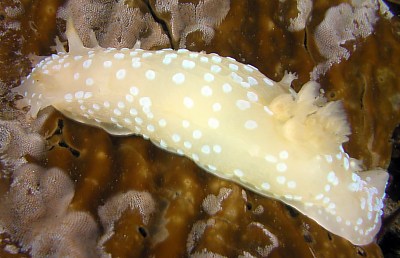
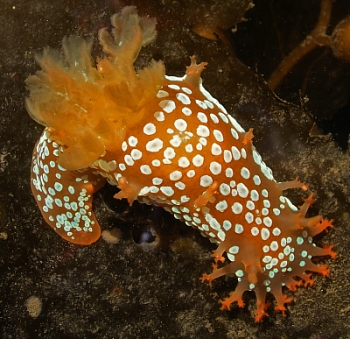
Triopha maculata
MacFarland, 1905
Order: NUDIBRANCHIA
Suborder: DORIDINA
Superfamily: ANADORIDOIDEA
Family: Polyceridae
Subfamily: Triophinae
DISTRIBUTION
West coast of North America from Canada (Vancouver) to Baja California, Mexico.
PHOTO
Upper: on a sandy bottom near the Monterey Breakwater, California, USA, Depth approx 10m. Approx 15 cm long. Photo: Clinton Bauder.
Lower: Cabrillo Beach boat launch, San Pedro, Surface water, less than one meter, California, USA, Pacific Ocean, 28 May 2006, Next to a boat dock on kelp leaves. Length: 15 cm. Photographer: Jim Lyle.
Ranges in background colour from a translucent pale yellow, through orange and red, to dark brown. The body is covered with raised white to bluish spots. The head veil has 10 to 12 branched processes along the edge, and like the rhinophore clubs these are usually a darker version of the background colour. Although they can grow to 18 cm in length, 2-5 cm is a more usual length.
-
Behrens, D., 1991 Pacific Coast Nudibranchs.
-
MacFarland, F.M. (1905) A preliminary account of the Dorididae from Monterey Bay, California. Proceedings of the Biological Society of Washington 18: 35-54.
-
MacFarland, F. M. 1966. Studies of opisthobranchiate mollusks of the Pacific coast of North America. Memoirs of the California
Academy of Sciences, 6: 1-546, pls. 1-72.
Rudman, W.B., 2002 (October 24) Triopha maculata MacFarland, 1905. [In] Sea Slug Forum. Australian Museum, Sydney. Available from http://www.seaslugforum.net/find/triomacu
Related messages
Triopha maculata mating
November 20, 2008
From: Gary McDonald
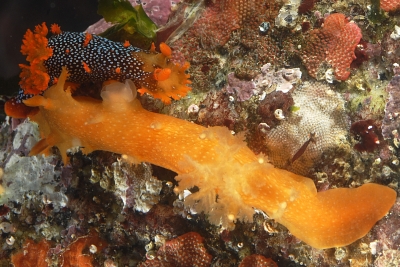
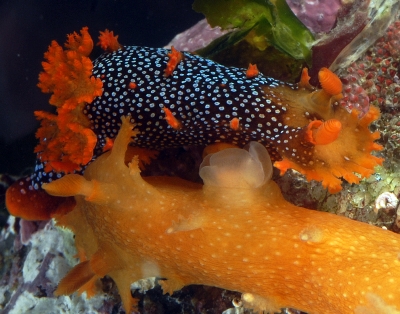
Concerning message #16396:
Hi Bill:
In the past I wasn't convinced that these two color forms of Triopha maculata belong to the same species. However, after finding these two individuals and placing them together in a small aquarium, and seeing them mate, I assume that they are indeed the same species. The small dark individual with dark orange gills is what I consider the typical coloration for adults of the species which are found in the rocky intertidal (as shown in MacFarland, 1966: pl. 19). I find individuals like the large pale specimen with pale yellow gills much less often; although small individuals (less than ~15 mm) are usually a more or less uniform orange color like the 13 mm long individual in the lower photo, or as in Clinton Bauder's photo [message #20299]
Locality: Upper Photo: Asilomar, Monterey Co.,, intertidal, California, USA, Pacific, 12 November 2008, Rocky intertidal. Length: 25 and 35 mm. Lower Photo: Carmel Pt., Monterey Co., California, USA, 22 December 2007. Photographer: Gary McDonald.
Gary McDonald
mcduck@ucsc.edu
McDonald, G.R., 2008 (Nov 20) Triopha maculata mating. [Message in] Sea Slug Forum. Australian Museum, Sydney. Available from http://www.seaslugforum.net/find/22051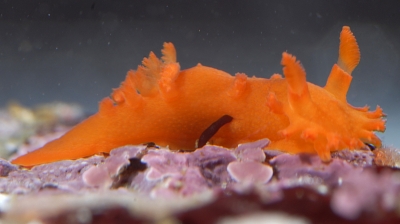
Thanks Gary,
Best wishes,
Bill Rudman
Orange sea slug?
September 10, 2007
From: Aria Guy
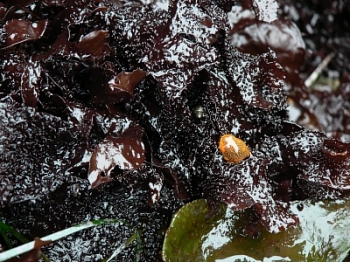
I found this very spherical, very orange, very interesting animal this morning in Pacifica, California. I'm incredibly curious; what is it?
Locality: Pacifica, 2 cm above sea level, CA, USA, Pacific Ocean, 03 August 2007, Tide pool. Length: 1 cm. Photographer: Peter Gross.
Aria Guy
ariarachel@gmail.com
Guy, A., 2007 (Sep 10) Orange sea slug?. [Message in] Sea Slug Forum. Australian Museum, Sydney. Available from http://www.seaslugforum.net/find/20393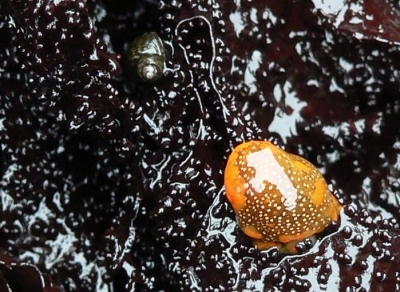
Dear Aria,
Your critter is the phanerobranch dorid nudibranch Triopha maculata. If the animal was submerged, the orange areas would be erect branched dorsal papillations that run down the sides of this species. The light blue spots on the orange-brown body also give this species away.
Thanks,
Dave Behrens
Triopha maculata feeding
August 9, 2007
From: Kevin Lee
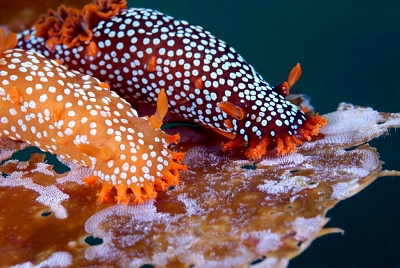
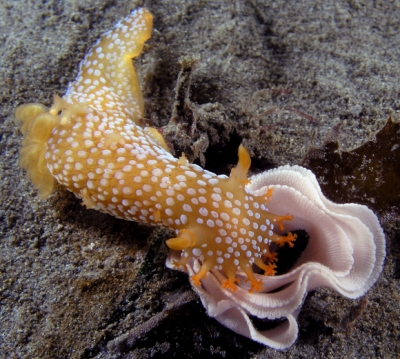
Here's a pair of Triopha maculata, found under a kelp leaf, a few weeks ago, at La Jolla Shores, Vallecitos Point, canyon. They were striking because of the color difference. From Dave's prior comments on Jim Lyle's posting (#16749 ), it appears the darker critter is the older. I do not know whether the pair were munching on the bryozoan on the kelp, but it certainly looked that way.
Locality: La Jolla, circa 90 feet, California, USA, Eastern Pacific, 07 July 2007, Sandy bottom, strewn with kelp blades. Length: 6 cm. Photographer: Kevin Lee.
Also, I include a photo of T. maculata, taken in August 2006, same location, alongside an egg coil, though I cannot confirm that the eggs belong to the nudi.
K:-)
diverkevin@gmail.com
Lee, K., 2007 (Aug 9) Triopha maculata feeding. [Message in] Sea Slug Forum. Australian Museum, Sydney. Available from http://www.seaslugforum.net/find/20369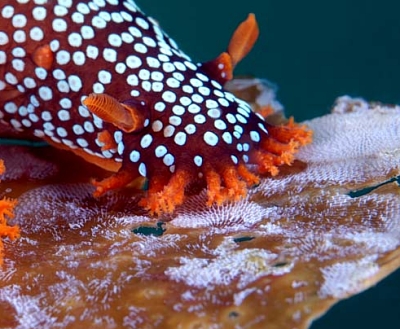
Hi Kevin,
Thanks for the great shots. Yes, this is the typical adult coloration with large pale blue spots, hence the name "maculate." From what I am hearing from other divers in your area, these guys are feeding on this encrusting bryozoan, Membranipora.
I can confirm that the egg mass is indeed that of T. maculata. Typical large cream white coil attached to the substrate on edge.
Thanks for sharing,
Dave Behrens
Triopha maculata from California
July 30, 2007
From: Clinton Bauder
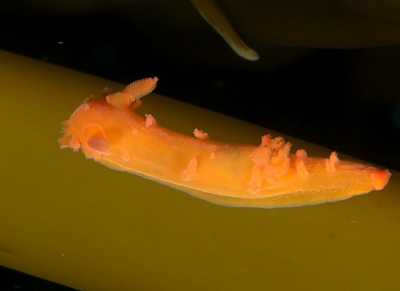
Hi Bill,
One of the nice things about diving in a kelp forest is that you don't have to stop looking for slugs during your ascent and safety stops. Dive buddy Allison Lee found this Triopha maculata near the top of some Macrocystis kelp.
Locality: Point Sur, 6 meters, California, USA, Pacific, 21 July 2007, Macrocystis kelp. Length: 10 mm. Photographer: Clinton Bauder.
Clinton Bauder
gecko1@apple.com
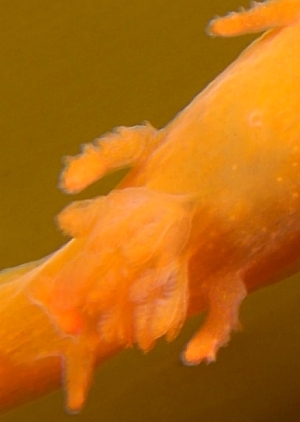
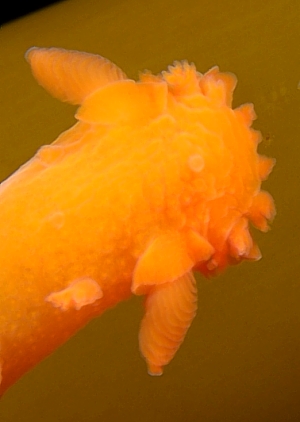
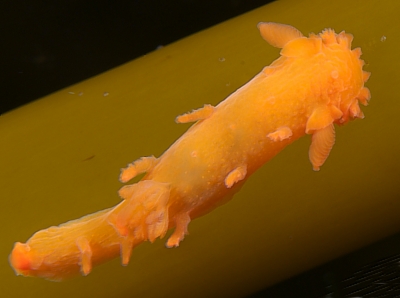
Hi Clinton,
Kelp beds like yours are the habitat for this species. Your specimen is obviously a juvenile. Bill's close-ups show the characteristic frontal veil and notal papillations. As this specimen approaches full adult size of over 15 cm, its characteristic blue spots will appear
Thanks for sharing,
Dave Behrens
Triopha maculata (?) from Southern California
June 15, 2006
From: Barbara J. Lloyd

Is this a Triopha maculata? Note the rhinophores. I looked at the other postings and I could not see the rhinophores well enough to compare them. I didn't even notice the spot on it until I was able to view it in a full screen.
If you look closely at the photo, it does show the characteristics 4 - 6 processes along the lateral ridge between the rhinophores and gill. I didn't have a picture which would confirm the frontal veil processes.
Locality: La Jolla Shores, 18.3 meters, La Jolla, CA, Eastern Pacific, 08 June 2006, Canyon wall between sandy zones. Length: 5 - 7 cm. Photographer: Barbara J. Lloyd.
Barbara J. Lloyd
barbara.lloyd@gmail.com
Lloyd, B.J., 2006 (Jun 15) Triopha maculata (?) from Southern California. [Message in] Sea Slug Forum. Australian Museum, Sydney. Available from http://www.seaslugforum.net/find/16852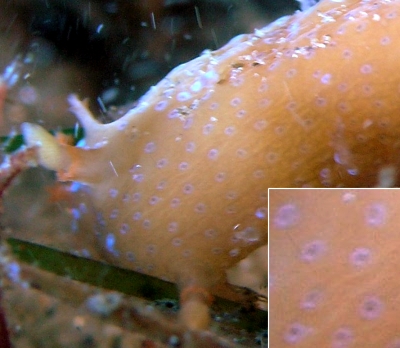
Hi Barbara,
Yes indeed this is Triopha maculata, the deep reddish-brown kelp canopy variation. For some reason your critter is just really, really pale. The uniform blue spots are a give away.
A couple dozen years ago, Branchologists felt that there were two separate species (a yellow form and an orange form - both of which were alway very small -, and the large brownish-red form). The yellow and orange forms were referred to as Triopha grandis and the brown, Triopha macualta. All have the blue spots if you look carefully. Subsequent careful examination of the internal anatomy shows all three colors to be different ages of the same species.
Thanks
Dave Behrens
Triopha maculata from Southern California
June 3, 2006
From: Jim Lyle

Los Angeles area nudiphiles were delighted to learn from Phil Garner that some interesting nudibranchs had been discovered in shallow water near the Cabrillo Beach boat launch. Along with many Melibe leonina, Janolus barbarensis, and Hermissenda crassicornis, were some large Triopha maculata. I must admit, I was startled to find individual T. maculata that were upwards of 15 cm long. The branchs were found on giant kelp leaves, just under the surface of the water.
Locality: Cabrillo Beach boat launch, San Pedro, Surface water, less than one meter, California, USA, Pacific Ocean, 28 May 2006, Next to a boat dock on kelp leaves.. Length: 15 cm. Photographer: Jim Lyle.
Jim Lyle
jlyle@adelphia.net
Lyle, J.L., 2006 (Jun 3) Triopha maculata from Southern California. [Message in] Sea Slug Forum. Australian Museum, Sydney. Available from http://www.seaslugforum.net/find/16749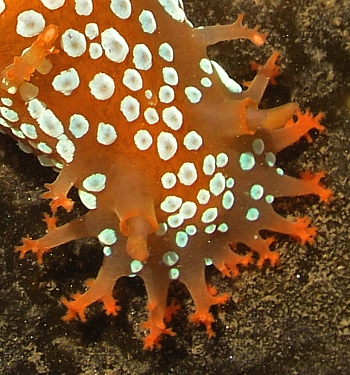
Hi Jim,
This is exactly where you will find this color morph of Triopha maculata. They are feeding on arborescent bryozoans (typically Bugula and Crisia) living on the kelp.
It is interesting to note that this color morph is almost never found on any substrate, other than kelp (unless it falls off), and as they get to this size the brownish-orange deepens and the spots become very blue. We have actually documented specimens up to 18 cm. Huge.
You should be finding very large, cream colored egg coils up in the canopy with them. A photo of the would be a nice addition
Thanks
Dave Behrens
Triopha maculata (?) from California
June 29, 2005
From: Ken-ichi Ueda
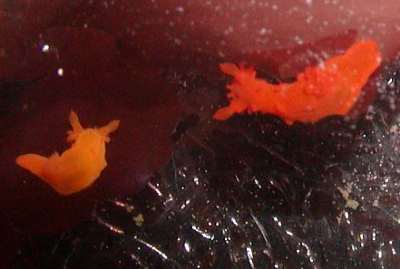
I found these nudibranchs that fit the description for Triopha maculata, except they lacked their namesake spots. I know these pictures aren't the best, but they really were a very consistent shade of orange. Otherwise they fit the description in Behrens 2nd ed.: lamellate rhinophores, about 4 pair of processes on the dorsum, and branched processed on the frontal veil.
Locality: Bean Hollow State Beach, Pescadero, California, USA. intertidal. Length: 15 mm. 23 June 2005. Photographer: Ken-ichi Ueda
Can anyone help me with the ID? Is this a spotless morph of T. maculata, or a different species?
Ken-ichi Ueda
kenichi.ueda@gmail.com
Ueda, K. M., 2005 (Jun 29) Triopha maculata (?) from California. [Message in] Sea Slug Forum. Australian Museum, Sydney. Available from http://www.seaslugforum.net/find/14124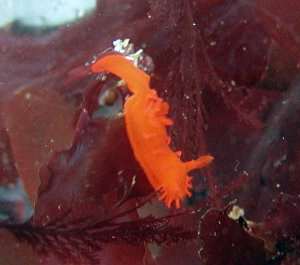
Dear Ken-ichi,
If its not a form of T. maculata I am sure one of our many Californian experts will let us know
Best wishes,
Bill Rudman
Triopha maculata from California
July 30, 2004
From: Bruce Wight
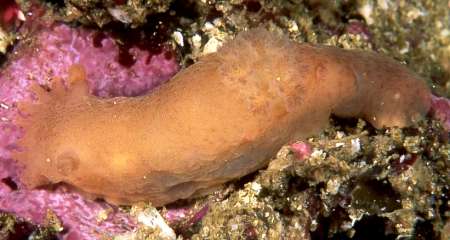
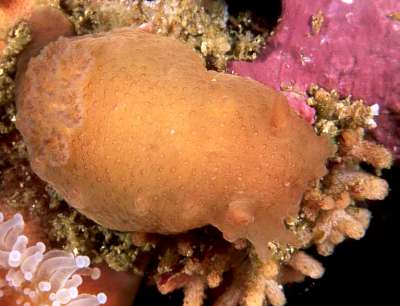
Hi guys, hope all is well with all of you. We went out to San Miguel Island, Channel Ids, California, over the weekend [July 2004] with the SDUPS. Water clarity was poor, but the place was loaded as always with branchs. Photographed a couple I need
help identifying. This one appears to be a Triopha of some kind.
Thanks
Bruce Wight
bruce.c.wight@boeing.com
Wight,, B., 2004 (Jul 30) Triopha maculata from California. [Message in] Sea Slug Forum. Australian Museum, Sydney. Available from http://www.seaslugforum.net/find/12708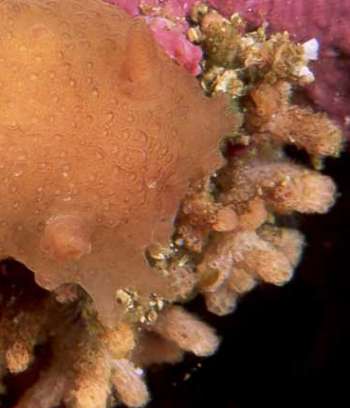
Thanks Bruce,
You will see in Jeff Goddard's message [#12724] that he thinks this is a colour form of Triopha maculata. It seems to be feeding - or at least to be quite interested in - the branching bryozoan colony in the close-up alongside. Can anyone identify it or comment on whether it is a potential food of this species?
Best wishes
Bill Rudman
Re: Triopha maculata from California
July 30, 2004
From: Jeff Goddard
Hi Bruce,
Your Triopha [#12708] looks like a variant of T. maculata to me, especially with the small white spots.
Best,
Jeff Goddard.
goddard@lifesci.ucsb.edu
Goddard, J., 2004 (Jul 30) Re: Triopha maculata from California. [Message in] Sea Slug Forum. Australian Museum, Sydney. Available from http://www.seaslugforum.net/find/12724Triopha maculata from Monterey, CA
October 25, 2002
From: Clinton Bauder
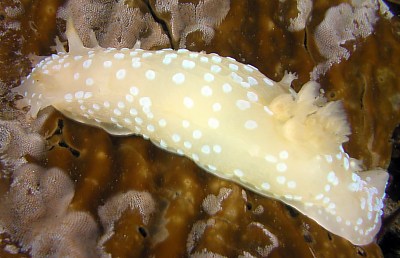
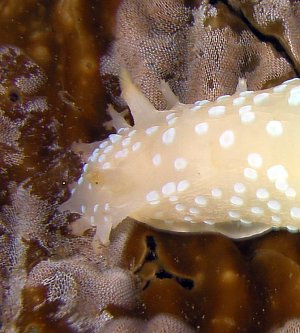
Hi Bill,
Here is another one for the Forum. This is the yellow phase of Triopha maculata. It's about 150mm long and was found on a sandy bottom near the Monterey Breakwater, California, at a depth of about 10m. I don't know if it was eating the bryozoans on the kelp or not. It was crawling along at a good clip on the kelp when we found it and I'll admit to picking it up and putting it back for the photo after it crawled onto the sand.
Clinton
gecko1@apple.com
Bauder, B., 2002 (Oct 25) Triopha maculata from Monterey, CA. [Message in] Sea Slug Forum. Australian Museum, Sydney. Available from http://www.seaslugforum.net/find/8067Thanks Clinton,
Certainly another interesting addition to the Forum
Bill Rudman
